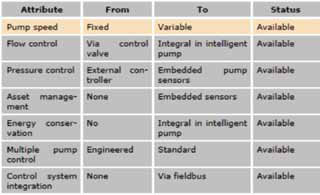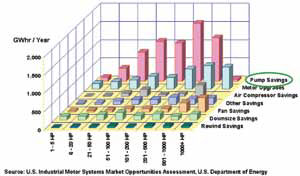Improvements in performance and energy reduction can be achieved with smart drives and system optimization.
Intelligent pumping is simply defined by ARC Advisory Group as the combination of a pump and a VFD with digital control capability. While this defined the beginnings of the intelligent pump trends, we now see numerous specific drivers around topics such as:
- Energy management
- Application specific algorithms
- Pump OEM-specific application programs
The term intelligent pumps is broadening to include the sensors that collect data and transmit pumping system performance. Some key attributes involved with intelligent pump systems include variable speed and multiple pump control come.
 |
| Table 1. Intelligent pump capabilites |
Intelligent Pumps and Energy Savings
While the building automation industry has embraced the intelligent pumps trend strongly, accounting for almost 50 percent of all intelligent pumping revenues, many other industries are leading the way—such as water/wastewater, mining and minerals, pulp and paper and oil and gas.
Figure 1 shows the areas in which industries can take action to reduce energy consumption. While many companies focus on areas such as HVAC systems and motor retrofits, it is clear that pump system upgrades provide the largest energy savings potential. Figure 2 provides insight into the key industry segments that have the most to gain from energy-savings initiatives. The potential in energy savings with intelligent pumping can add as much as 20 percent to the bottom line, according to the U.S. Department of Energy.

Figure 1. Areas with potential for energy savings

Figure 2. Industry segments that can most benefit from energy-saving initiatives
In addition to energy, other key drivers include OEM initiatives, such as OEM personalization. OEMs can customize software to either match pumping systems to application needs and/or pre-load pump data to greatly simplify start up and commissioning requirements.
Intelligent Pumps in the Oil & Gas Industry
There is particular excitement about intelligent pumping solutions in the oil and gas industry, specifically in the opportunities to improve the output of mature oil fields.
Most mature, onshore oil wells are not big producers, with many producing less than 10 barrels of oil per day. Pumpjack systems, progressive cavity pumps (PCP) and electrical submersible pumps (ESP) work hard to bring oil to the surface, and more operators are deploying carbon dioxide injection and other enhanced recovery techniques to boost production rates and extend field life.
Many operators deploy conventional time-on/time-off pump controls to prevent a pumped off condition from occurring. These controllers stop the pump jack for a predetermined period to ensure fluid is available before restarting the lift. Although simple to operate and adjust, they do not ensure maximum production recovery is achieved and only work as a safety mechanism to prevent damages caused by pumping a dry well.
Process efficiency is most improved with an intelligent pumping solution that employs a variable frequency drive to provide pump off control by varying the speed of the well and maintaining an effective fill level. Efficiency can be further improved by using information about the condition of the well to optimize the pump speed. The ultimate, intelligent pumping solution is one that takes advantage of this information in real-time and constantly optimizes the pump speed. In some more shallow wells, this can be done by using the motor load information in the drive as the primary data point. Deeper wells should take advantage of load profile information directly from the rod and,
ideally, the calculated or “down-hole” load profile information. Systems that employ such a solution are called fully optimized. A typical productivity improvement for such systems might be 5 percent. However, the results vary substantially up or slightly down based on the natural performance of the well in its previous, un-optimized state.
Pumpjack optimization can include scalable options for an operator:
- Torque only. This solution uses pump motor load information to understand well conditions and determine optimum speed. It is the least costly solution for wells with depths of up to 500 meters.
- Surface Card. This solution uses feedback from a rod-mounted load cell (dynamometer card) to analyze well conditions. It can optimize speed and fill rate for deeper wells.
- Down-Hole Card. This solution uses an advanced algorithm to compute the rod load at the bottom of the well. This represents the ultimate solution with the greatest optimization and return on investment.
The elements of such a system include a variable frequency drive to control the pump motor speed; instrumentation to detect well conditions; and an embedded controller to operate the well, read the instrumentation, calculate an optimized speed command for the drive and provide host communication.
A fully optimized pumpjack is not only more productive but also has a higher availability and longer equipment life. Most of the wear and maintenance issues associated with pumpjack operation are reduced as the optimized system automatically reduces operating conditions that cause undo wear (i.e., fluid pound, gas compression). Optimized wells also require much less human intervention because the optimization adapts to changing conditions in the well automatically. Cases have occurred where the maintenance related downtime for a pumpjack system has been reduced by as much as 80 percent. While that may not be typical, it shows how some of these systems running open loop are hurting the equipment.
Beyond individual pumpjack systems, the oil field as a whole can be further optimized by making an enterprise of the entire field. A “digital oil field” is based on a suite of interactive and complementary technologies that allow operators to gather and analyze information from wells to more strategically manage a lease. It employs a scalable, modular and collaborative architecture that leverages intelligent pumping solutions and the capabilities of modern information technology to deliver actionable information directly from a well to the field's central control station. This real-time data can prompt better and timelier decisions that improve production, and ultimately, shift the paradigm from merely operating a lease to managing it to its fullest potential.
Implementing the digital oil field starts with extending remote communication to the oil field assets. This includes the pumpjack systems as well as other pump system types (PCP, ESP, Injection, etc.) and ancillary equipment such as tank level and flow monitoring applications. Radio and cellular telemetry options are a must for intelligent pumping applications in oil fields. Telemetry can provide remote monitoring and secure control of oil field assets. This can be in the form of remote individual operators or more sophisticated central, control station operating rooms connected to intelligent pumping systems. This connectivity along with the intelligence of the individual pumping solutions means fewer interventions in the field to address pump system issues and optimize well performance.
Many owners and operators of small- to medium-sized oil fields are less than motivated to make large capital investments in new oil wells. In such an environment, a mark of success is keeping wells consistently pumping and doing so at an optimum level rather than just creating new wells. In addition to injection methods, intelligent pumping solutions can represent a more scalable investment to maintain and improve oil field production. Also, the network connectivity provided by telemetry equipment can provide data for personnel to conduct operational assessments, including costs and payouts, to extend and maximize oil field performance.
Pumps & Systems, October 2010

